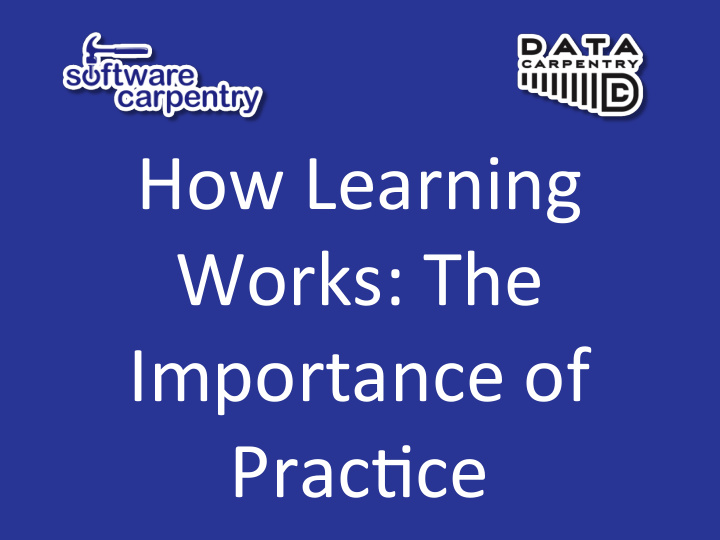



How Learning Works: The Importance of Prac9ce
Carpentries’ Pedagogical Model • Favour prac%cal and hands-on ▪ Teach, prac9se, feedback, next step -> loop • Develop learners’ confidence • Lay founda9on for future learning
Cogni9ve Development and Mental Models • Mental model : concepts/facts + rela9onships • Effec9ve learning happens when a learner creates a mental model of the domain • Characterise the skill level to know how best to teach them to develop a mental model
How to Characterise Skill? • Differences in skill – mental model ‘big picture’ • Dreyfus model of skill acquisi9on simplified: Novice Expert Competent Practitioner Doesn’t know what they Good mental model for Can handle out of the don’t know – no mental everyday purposes, e.g. ordinary situations model (key ideas) of driver and car domain Diagnose problem Model perhaps not causes Reason by analogy and completely accurate guesswork Can do normal tasks Borrow from other with normal effort under mental models that normal circumstances seem similar
Tutorial vs Manual • Novices, competent prac99oners & experts need to be taught differently vs Reference Manual Tutorial
Carpentry Learners are Novices 5-15% use GPU clusters 85-95% send each to analyze petabytes other spreadsheets in the cloud by email • Help them develop a working mental model • Easy to overload novices with too many facts ▪ Unix shell lesson – 16 commands in 3 hours!
The Importance of Going Slowly “If someone feels it’s too slow, they’ll be bored. If they feel it’s too fast, they’ll never come back to programming. ” - a Carpentry instructor • Meet learners where they are at, whatever the star9ng point or current skillset • Adjust our teaching to their skill level to aid learning, without making them feel inferior
Exercise 1: Mental models • Write some aspects of the mental model you use to frame and understand your work • What concepts/facts are included? What types of rela9onships are included?
How “Knowledge” Gets in the Way “It ain’t what you don’t know that gets you into trouble, it’s what you know for sure that just ain’t so” – Mark Twain • Clearing up learners’ misconcep9ons: ▪ Simple factual errors – easiest to correct ▪ Broken models – correct by reasoning, address contradic9ons Our focus! ▪ Fundamental beliefs – e.g. “world is only a few thousand years old”, can’t really address these
Iden9fying and Correc9ng Misconcep9ons • Instructors need feedback! • Need an insight into/to assess mental model of students • Should be done frequently!
Assessing Mental Models • To expose incomplete/broken mental models • Repe99on vs. reflec9ve prac9ce Summative Assessment Formative Assessment Guide learning by informing instructor and learner what to focus on Did desired learning take place? Takes place during teaching Can learner move on? No pass or fail e.g. a driving test Our focus! Pass or fail
Mul9ple Choice Ques9ons • Forma9ve assessment needs to be quick to administer and evaluate and comes in many forms – e.g. MCQs Q: what is 27 + 15? a) 42 b) 32 c) 312 d) 33
Exercise 2: Iden9fying Misconcep9ons Q: what is 27 + 15? a) 42 b) 32 c) 312 d) 33 Choose one wrong answer and write what the misconception is associated with it
Applying MCQs 1. Teach some stuff 2. Present MCQ probing for misconcep9ons 3. Students vote on MCQ answers Mostly all right answers, move on ▪ Mostly all same wrong answer, address misconcep9on ▪ Mix of right and wrong, rewind to previous point where all ▪ were on the same page, or get them to discuss • Do it frequently - e.g every 15 mins or so • Preemp9vely! • Break-up teaching and re-focus ajen9on
Notes on MCQs • A good MCQ tests for conceptual misunderstanding , not factual knowledge • For distractors, think about problems from previous training events • MCQs are useful even if not used in class!
Exercise 3: Design a MCQ • Create mul9ple choice ques9on related to topic you intend to teach • Explain diagnos9c power of each distractor, i.e. what misconcep9on is each distractor meant to iden9fy? • Pair up with your neighbour and discuss your MCQs, providing feedback
Summary • Our goal as experts when teaching novices is to help them build useful mental models and correct misconcep9ons • Use reflec%ve prac%ce • Forma%ve assessment provides feedback for both instructors and learners • Forma9ve assessment is most powerful when instructor modifies her teaching (change pace, rewind, refocus) based on the result
Recommend
More recommend